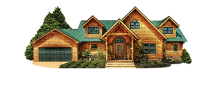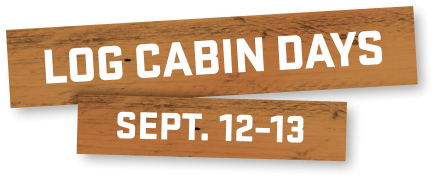There are a few things you can do to expedite the log home design process. The three most important are: #1 Do your homework! #2 Do your homework! #3 Do your homework!
Being able to give the designer all the required information up front will speed up the process and you will end up with a better home design.
1. Start Early To Avoid Delays
It’s never too early to start the planning process once you have secured the property. While you can dream and think about it before-hand don’t get a professional involved until the property is secured. It is far more pleasant to plan a home when your schedule isn’t too tight. Too often decisions get made without the needed time to think it through.
2. Get A Topographical And Surveying Map
These two items can help when doing your elevation drawings. Having the Topographical helps to take out the guess work. It will help the estimator get a more accurate quote in determining the amount of stone to cover your foundation, chimney and the size of the stairs and railing. It can gives the builder a better idea on what to figure for his cost such as the driveway.
3. Determine The Best Placement Or Your Home
You will want to determine where on the property to place your home and how to arrange the rooms or spaces to best fulfill your needs and desires, and to get the maximum potential from it. The tools you will need are your survey and topography map, a few stakes, tape measure, perhaps a role of string and lots of paper!
You may have tentatively decided where to put your home when you bought your property. In fact, it may be the reason you bought it in the first place. With smaller lots you still want to arrange the rooms or spaces, but the placement of the home is normally a given. Sometimes, though, moving it 50 feet or turning it 10 degrees can make a difference in the enjoyment of your home, such as giving you a better view, and a safer, more convenient entrance, etc.
Taking advantage of a view is only one of the many considerations of locating your home. High points, low points, ravine, knoll, lake/pond, swamp, woods, creek, short views, distant views, traffic, roads, fence rows, neighboring houses, sunrise, sunset, solar south, north/south, prevailing winds, safe driveway entrance, driveway, parking, garage, walkways, walkout, outbuildings, garden areas, septic and well.
Take a copy of your survey map and sketch on it any of these applicable features. Consider camping out on the property a few nights. You might be surprised what you can learn from that experience.
4. Create A Bubble Drawing For Room Layout
Once you know where you want to your home, make a bubble drawing. You do this by standing in the middle of where your home will be with a piece of paper and draw circles where each room will go. Larger circles for larger areas, such as the great room and smaller circles for smaller areas, like the bathrooms.
Start with the focal point, or most important space, which might be the family room. Normally you would put it where you can take advantage of the best view. However, there may be other considerations such as passive solar. Perhaps you want the great room facing the front overlooking the drive or road and save the best view for the sunroom. Whichever it may be, make a circle for it and label it.
Next in importance may be the kitchen and a garage if you’re having one. Most people want the kitchen next to the garage or breezeway leading to it. You determine the relation of each room to each other like that, making circles for each one. Ask yourself questions like, would I rather read the paper, watch the sunrise and sip my coffee from the bedroom or from the kitchen/dining area? Paper is not expensive, keep drawing until you’re happy with the result.
5. Convert The Bubble Drawing Into A Square Sketch
After you’re satisfied with the bubble drawing in the field, make squares for each room or blocks, arranged in a similar manner. No need to draw to scale just yet, other than make big squares for larger areas and little squares for smaller areas.
As you do this, the plan will take shape and form rather mysteriously. Remember, it’s still only paper drawings and you can sketch, draw, and redraw till you get it right. Once it’s converted to squares you redraw it to scale and add stairs, bathrooms, and other secondary rooms.
As you move things around so they flow and fit, you may have to adjust some of the room sizes to accompany each other. In a log home with heavy timbers you will need to plan on having posts down the center of the home, and they need to line up with the posts in the basement. Arrange the rooms and posts so they don’t interfere with your layout.
6. Establish A Realistic Budget
Before you get too far into planning your dream, you should, if you haven’t already, get pre-qualified at your bank. Establishing a realistic budget is a “must do” before you go to your designer.
Once it’s all together to scale, calculate the square feet of living space. If it’s too large for your budget, then rethink your room size needs and compromise where you can. Rooms that get used a lot (kitchen/living areas) leave bigger and more to the size you think you will need. Areas you use less (bedrooms/master bath) consider reducing and modifying more. Other areas, like sunrooms and garages, consider adding later. Get an average, workable, per square cost from your log home manufacturer.
Resist the temptation to make the home so large that it stretches your budget to the point where you have to compromise the quality of your home. Or worse yet, give up your dream. When making quality of material decisions, always compromise on items that can easily be upgraded or replaced down the road, but don’t compromise on items more permanent.
7. Create Your Dream Wishlist
Whenever you see something you like in a magazine, keep it for future reference. Keep them organized into categories such as: exterior ideas, kitchen ideas, great room ideas, etc. Remember to also gather landscape ideas and small details like electrical box covers, lighting fixtures, doors, windows, stain colors, flooring, faucets, and other items. Take pictures when visiting friends or touring model homes.
Keep these items in a handy, well organized file. Eventually, you will be showing your dream wish list to your designers. This can help them understand what you like, and in turn, incorporate your ideas into your plans.
8. Check Building Department Requirements And Codes
Contact your local building department and find out what codes they follow, including energy codes. Be sure you ask what your areas ground snow load is. Get all their contact information as the designers may have further questions.
9. Meet With The Designer
Load up all your sketches along with clippings, ideas, and pictures, and plan on a long meeting with your designer, if there are two of you, both of you need to go. Time spent now can save time later with phone calls and questions, etc. Do go with an open mind. The designer will have ideas from his experience and expertise that can greatly enhance your log home.
10. Share Your Budget
This is important information that they need in order to get your home near your targeted budget. Otherwise, they will be like someone trying to hit a target blind-folded.
11. Review And Refine Concept Drawings
First, you will want your designer to draw concept drawings for you to review. If you did your homework well the designer should be able to get it on the first try, but don’t be discouraged if he doesn’t. With a few times back and forth, you should be able to have it your way.
12. Evaluate and Adjust Final Drawings
When you receive the concept drawings back from the designer, you will want to do some serious reviewing. Imagine each scenario of your home life and living habits like this: Suppose visitors arrive. Will they find the door you want them to? They come to the door, and you welcome them. If they’re friends you invite them in, take their jackets and you hang or lay them, where? You invite them to sit down. You offer them refreshments. You get it and serve. They ask to use the bathroom. You show them. You excuse yourself to prepare dinner. She offers to help. You graciously accept her offer.
Try to get the whole family involved in brainstorming like this. Ask yourself, who, what, where, when and how. Each family has to think what’s important to them. Spend a lot of time thinking about these things.
Also, cut out paper to imitate furniture sizes. Arrange them and make sure there’s room to accommodate what you need. Once you’ve decided where things go you might glue them on your plans and do your “imagining living in the home” after you place the furniture.
Mark all your changes in red so that the designer doesn’t miss anything. After you are done with the exercise take or send the drawings back to the designer.
Other considerations for designing your log home
Avoid the temptation of having a well-meaning friend or relative drawing up your log home who doesn’t thoroughly understand the construction of a log home. After the preliminary plans are done get a quote for the package and the construction of your home. With that information, secure the funds before you commit and pay for the final construction drawing. This could save you a lot of time and money in case it goes over your budget.









